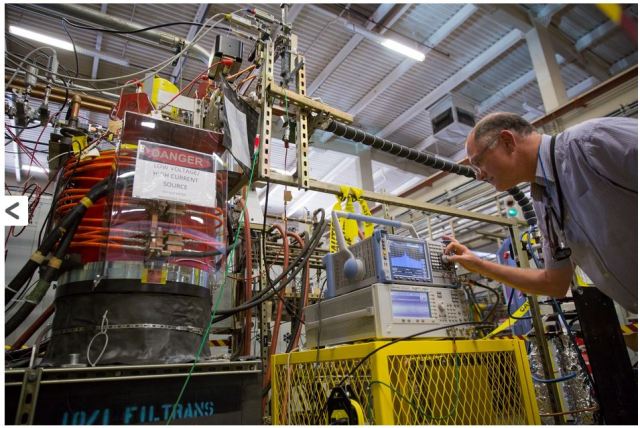Aug 11 2015
Accelerator technology pioneered at the Department of Energy’s SLAC National Accelerator Laboratory is on its way to powering X-ray science in South Korea: On Aug. 6, the lab shipped one of its unique radio-frequency amplifiers – an XL4 klystron – to Pohang Accelerator Laboratory (PAL), where it will become a key component for the optimal performance of a new X-ray free-electron laser under construction.
 In a diligent, two-month-long process, SLAC engineers tested the first of the XL4 klystrons built for PAL. (SLAC National Accelerator Laboratory)
In a diligent, two-month-long process, SLAC engineers tested the first of the XL4 klystrons built for PAL. (SLAC National Accelerator Laboratory)
Klystrons are the driving force behind many particle accelerators. They generate powerful radio-frequency fields that provide the energy to bring charged particles up to speed for collision experiments and the production of intense X-rays.
However, SLAC’s XL4 klystron, which operates in a particular frequency range known as the X-band, will serve another purpose at PAL: It will power accelerator structures that let scientists optimize the electron beam in the future X-ray laser.
“We are the world’s experts for X-band radio-frequency accelerator technology,” says SLAC’s Michael Fazio, who leads the lab’s Technology Innovation Directorate (TID). “PAL and SLAC have a collaborative agreement under which SLAC is providing klystrons and other accelerator components for the new X-ray laser.”
Optimizing X-ray Laser Performance in South Korea
PAL is building an X-ray laser similar to SLAC’s Linac Coherent Light Source (LCLS), a DOE Office of Science User Facility that generates the most powerful X-rays on Earth. With their extremely bright and ultrashort light pulses, X-ray lasers enable groundbreaking research in many scientific areas, from materials science to biology to studies of matter in extreme conditions.
These state-of-the-art light sources produce X-ray light by sending short electron bunches on a wavy path inside special magnets.
“For the best X-ray laser performance, the electron bunches must be very short, on the order of only tens to hundreds of a quadrillionth of a second,” says SLAC engineer Erik Jongewaard, the project leader of the collaboration with PAL. “However, bunches produced by the laser’s electron source itself are too long and need to be shortened by bunch compressors.”
This is where SLAC’s XL4 klystron comes in: It delivers energy to a so-called X-band linearizer – an accelerator structure that manipulates bunches in such a way that they can be optimally shortened in the subsequent bunch compressor.
“This manipulation can conveniently be done in the X-band,” Jongewaard says. “When it comes to X-band accelerator technology, SLAC is the only place in the world where you can go from concept through design, engineering, fabrication, testing and operation all in one place and where the entire system can be specified and optimized.”
For the South Korean X-ray laser project, PAL therefore began collaborating with SLAC in 2012.
“Under the $3.4-million agreement, our team built the linearizer components including two XL4 klystrons,” says SLAC’s Lisa Bonetti, head of the TID Advanced Prototyping, Fabrication and Test Facilities department. “We also trained PAL engineers here on site in using our X-band technology.”
The first klystron and other parts are now on their way to PAL. The second klystron, which will serve as a spare but could potentially also be used in a tool to diagnose the X-ray laser’s electron and X-ray beams, is currently being tested.
Exporting Expertise Built on Decades of Research
SLAC’s unparalleled expertise with X-band technology goes back to the 1980s when researchers began thinking about an energy upgrade of the lab’s 2-mile-long linear accelerator to enable new particle physics experiments. Given the choice of either building an even longer accelerator or developing klystrons that drive particles to higher energies, scientists opted for the latter. This marked the birth of SLAC’s X-band program.
Although the linear accelerator never got its energy upgrade, the X-band technology kept developing. The latest klystron model is the XL4 – an extraordinarily stable radio-frequency source with 50 million watts of peak power. At SLAC, two of them are integrated into LCLS while others power experiments at the lab’s Next Linear Collider Test Accelerator (NLCTA) and Accelerator Structure Test Area (ASTA).
“SLAC has built a total of 22 XL4 klystrons to date, including a modified version, called the XL5, for accelerator facilities in Europe,” Jongewaard says. “Three are used in Switzerland: one at CERN and two at the Paul Scherrer Institute. We also built another two for the Elettra research center in Italy.” The XL5 model is now commercially produced by Communications & Power Industries, a Palo Alto-based company.
Soon, SLAC’s X-band radio-frequency technology will also benefit science in East Asia: Hopes are that PAL’s X-ray laser will produce its first light in 2016.